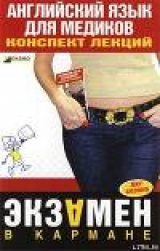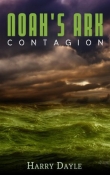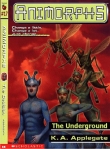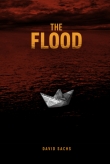
Текст книги "Английский язык для медиков: конспект лекций"
Автор книги: Елена Беликова
Жанры:
Языкознание
,сообщить о нарушении
Текущая страница: 5 (всего у книги 12 страниц)
ЛЕКЦИЯ № 15. Blood
Blood is considered a modified type of connective tissue. Mesoder-mal in origin, it is composed of cells and cell frag ments (erythrocytes, leukocytes, platelets), fibrous proteins (fibrinogen – fibrin during clotting), and an extracellular amorphous ground substance of fluid and proteins (plasma). Blood carries oxygen and nutrients to all cells of the body and waste materials away from cells to the kidney and lungs. It also contains cellular elements of the immune system as well as humoral factors. This chapter will discuss the differ ent elements of blood and the processes by which they are formed.
Formed elements of the blood
The formed elements of the blood include erythrocytes, leukocytes, and platelets.
Erythrocytes, or red blood cells, are important in trans porting oxygen from the lungs to tissues and in returning carbon dioxide to the lungs. Oxygen and carbon dioxide carried in the RBC combine with hemoglobin to form oxyhemoglobin and carbaminohemoglobin, respectively.
Mature erythrocytes are denucleated, biconcave disks with a diameter of 7-8 mm. The biconcave shape results in a 20-30% increase in sur face area compared to a sphere.
Erythrocytes have a very large surface area: volume ratio that allows for efficient gas transfer. Erythrocyte membranes are remarkably pliable, enabling the cells to squeeze through the narrowest capillaries. In sickle cell anemia, this plasticity is lost, and the subsequent clogging of capillaries leads to sickle crisis. The normal concentration of erythrocytes in blood is 3,5-5,5 million/mm3 in women and 4,3– 5,9 million/mm3 in men. Higher counts in men are attributed to the erythrogenic androgens. The packed volume of blood cells per total volume of known as the hematocrit. Normal hematocrit values are 46% for women and 41-53% for men.
When aging RBCs develop subtle changes, macrophages in the bone marrow, spleen, and liver engulf and digest them. The iron is carried by transferring in the blood to certain tissues, where it combines with apoferritin to form ferritin. The heme is catabolized into biliver-din, which is converted to bilirubin. The latter is secreted with bile salts.
Leukocytes, or white blood cells, are primarily with the cellular and humoral defense of the organism foreign materials. Leukocytes are classified as granulocytes (neutrophils, eosinophils, basophils) and agranulocytes (lympmonocytes).
Granulocytes are named according to the staining properties of their specific granules. Neutrophils sare 10-16 mm in diameter.
They have 3-5 nuclear lobes and contain azurophilic granules (ly-sosomes), which contain hydrolytic enzymes for bacterial destruction, in their cytoplasm. Specific granules contain bactericidal enzymes (e. g., lysozyme). Neutrophils are phagocytes that are drawn (chemo-taxis) to bacterial chemoattractants. They are the primary cells involved in the acute inflammatory response and represent 54-62% of leukocytes.
Eosinophils: they have a bilobed nucleus and possess acid granulations in their cytoplasm. These granules contain hydrolytic enzymes and peroxidase, which a discharged into phagocytic vacuoles.
Eosinophils are more numerous in the blood durii asitic infections and allergic diseases; they norma asent onlyi – 3% of leukocytes.
Basophils: they possess large spheroid granules, which are basophi-lic and metachromatic, due to heparin, a glycosaminoglycan. Their granules also contain histamine.
Basophils degranulate in certain immune reaction, releasing hepa-rin and histamine into their surroundings. They also release additional vasoactive amines and slow reacting substance of anaphylaxis (SRS-A) consisting of leukotrienes LTC4, LTD4, and LTE4. They represent less than 1% – of leukocytes.
Agranulocytes are named according to their lack of specific granules. Lymphocytes are generally small cells measuring 7-10 mm in diameter and constitute 25-33% of leukocytes. They con tain circular dark-stained nuclei and scanty clear blue cyto plasm. Circulating lymphocytes enter the blood from the lymphatic tissues. Two principal types of immunocompetent lymphocytes can be identified using im-munologic and bio chemical techniques: T lymphocytes and В lymphocytes.
T cells differentiate in the thymus and then circulate in the peripheral blood, where they are the principal effec tors of cell-mediated immunity. They also function as helper and suppressor cells, by modulating the immune response through their effect on В cells, plasma cells, macrophages, and other T Cells.
В cells differentiate in bone marrow and possibly in the gut-associated lymphatic tissues (GALT). They are the principal mediators of humoral immunity through their production of antibodies. Once activated by contact with an antigen, they differentiate into plasma cells, which synthesize antibodies that are secreted into the blood, intercellular fluid, and lymph. В lymphocytes also give rise to memory cells, which differentiate into plas ma cells only after the second exposure to the antigen. They are responsible for the secondary, or amnestic response that occurs when the body is exposed to an antigen for a second time. Monocytes vary in diameter from 15-18 mm and are the largest of the peripheral blood cells. They constitute 3-7% of leukocytes.
Monocytes possess an eccentric U-shaped or kidney-shaped nucleus. The cytoplasm has a ground-glass appearance and fine azurophi-lic granules.
Their nuclei stain lighter than lymphocyte nuclei because of their loosely arranged chromatin.
Monocytes are the precursors for members of the mononuclear phagocyte system, including tissue macrophages (histiocytes), osteoclasts, alveolar macrophages, and Kupffer cells of the liver.
Platelets (thromboplastids) are 2-3 mm in diameter.
They are a nuclear, membrane-bound cellular fragments derived by cytoplasmic fragmentation of giant cells, called megakaryocytes, in the bone marrow.
They have a short life span of approximately 10 days.
There are normally 150 000-400 000 platelets per mm3 of blood. Ultrastructurally, platelets contain two portions: a peripheral, light-staining hyalomere that sends out fine cytoplasmic processes, and a central, dark-staining granulomere that con tains mitochondria, va-cuoles, glycogen granules, and granules. Platelets seal minute breaks in blood vessels and maintain endothelial integrity by adhering to the damaged vessel in a process known as platelet aggregation. Platelets are able to form a plug at the rupture site of a vessel because their mem brane permits them to agglutinate and adhere to surfaces.
Platelets aggregate to set up the cascade of enzymatic reac tions that convert fibrinogen into the fibrin fibers that make up the clot.
New words
blood – кровь
to be considered – рассматриваться
modified – измененный
mesodermal – мезодермальный
erythrocytes – эритроциты
leukocytes – лейкоциты
platelets – тромбоциты
fibrous proteins – волокнистые белки
cellular – клеточный
elements – элементы
immune – иммунный
humoral – гуморальный
important – важный
trans porting – транспортировка
carbon – углерод
dioxid – диоксид
to contain – содержать
circular – проспект
dark-stained – запятнанный
nuclei – ядра
scanty – скудный
precursors – предшественники
short – короткий
life – жизнь
span – промежуток
approximately – приблизительно
peripheral – периферийный
light-staining – легкое окрашивание
to aggregate – настраивать
to set up – устанавливать
Вставьте артикль, где необходимо.
1. He has… small family.
2. He has… father and… mother.
3. He has no… brother, but he has… sister.
4. His sister is… pupil.
5. She is… good girl, and she had… many Russian books, but she has no… English hooks.
6. There is… writing-desk in… room… writing-desk is good.
7. There is… lamp on.writing desk.
8. My uncle has… large family. They are six in… family.
9. My father is… engineer.
10. He works at… big factory.
11. We have… good library.
12. Our books are in… big bookcase.
13. In your sister… married?
14. What do you do after… breakfast?
15. I go to… school.
16. When do you come… home?
17. I come… home at… half past two.
18. Do you like to watch TV in… evening?
19. There is… paper on… writ ing-desk.
20. My… books and… exercise-books arc on… writing-desk, too.
Вставьте артикль, где необходимо.
1. What… colour is your new… hat?
2. It is… white.
3. Is there… refrigerator in your… kitchen?
4. Where is… refrigerator in your… kitchen?
5. IT is in… corner of… kitchen.
6. There are… mirrow in our… living-room.
7. There are… flowers in… vase.
8. I have… tea in my… cup.
9. He has no… coffee in his… cup.
10. What… book did take from… library on… Tuesday?
11. I have books,… exercise-books and pens.
12. I work.an office.
13. Whose.those pen?
Answer the questions.
1. How is the blood considered?
2. What is the blood composed of?
3. What does blood carry?
4. Where does the blood carry oxygen and nutrients?
5. What does the blood contain in the immune system?
6. What do the formed elements of the blood include?
7. Hoe do we also call red blood cells?
8. What area do erythrocytes have?
9. What do eosinophils have?
10. What appearance does the cytoplasm have?
Make the sentences of your own using the new words (10 sentences).
Find the definite and indefinite articles in the text.
ЛЕКЦИЯ № 16. Plasma
Plasma is the extracellular component of blood. It is an aqueous solution containing proteins, inorganic salts, and organic com pounds. Albumin is the major plasma protein that maintains the osmotic pressure of blood. Other plasma proteins include the globulins (alpha, beta, gamma) and fibrinogen, which is necessary for the formation of fibrin in the final step of blood coagulation. Plasma is in equilibrium with tissue interstitial fluid through capil lary walls; therefore, the composition of plasma may be used to judge the mean composition of the extracellular fluids. Large blood proteins remain in the intravascu-lar compartment and do not equilibrate with the interstitial fluid. Serum is a clear yellow fluid that is separated from the coagulum during the process of blood clot formation. It has the same com position as plasma, but lacks the clotting factors (especially fib rinogen).
Lymphatic vessels
Lymphatic vessels consist of a, fine network of thin-walled vessels that drain into progressively larger and progressively thicker-walled collecting trunks. These ultimately drain, via the thoracic duct and right lymphatic duct, into the left and right subclavian veins at their angles of junction with the internal jugular veins, respectively. The lymphatics serve as a one-way (i. e., toward the heart) drainage sys tem for the return of tissue fluid and other diffusible substances, including plasma proteins, which constantly escape from the blood through capillaries. They are also important in serving as a conduit for channeling lymphocytes and antibodies produced in lymph nodes into the blood circulation.
Lymphatic capillaries consist of vessels lined with endothelial cells, which begin as blind-ended tubules or saccules in most tis sues of the body. Endothelium is attenuated and usually lacks a continuous basal lamina. Lymphatic vessels of large diameter resemble veins in their struc ture but lack a clear-cut separation between layers. Valves are more numerous in lymphatic vessels. Smooth muscle cells in the media layer engage in rhythmic contraction, pumping lymph toward the venous system. Smooth muscle is well-developed in large lymphatic ducts.
Circulation of lymph is slower than that of blood, but it is nonetheless an essential process. It has been estimated that in a single day, 50% or more of the total circulating protein leaves the blood circulation at the capillary level and is recaptured by the lymphatics.
Distribution of lymphatics is ubiquitous with some notable excep tions, including epithelium, cartilage, bone, central nervous sys tem, and thymus.
New words
plasma – плазма
extracellular – внеклеточный
component – компонент
aqueous – водный
solution – решение
proteins – белки
inorganic – неорганический
salts – соли
organic – органический
com pounds – составы
albumin – альбумин
to maintain – поддерживать
globulins – глобулины
alpha – альфа
beta – бета
gamma – гамма
fibrinogen – фибриноген
equilibrium – равновесие
lymphatic – лимфатический
vessel – сосуд
endothelium – эндотелий
attenuated – уменьшенный
circulation – обращение
lymph – лимфа
distribution – распределение
ubiquitous – вездесущий
notable – известный
Перед названиями наук, учебных предметов и языков артикль не употребляется.
E. g. He studies _ chemistry.
I speak _ English.
Заполните пропуски, где необходимо.
1. My friend's. flat is very comfortable.
2. There are… three rooms in… flat:… living-room,… study and. bedroom.
3… living-room is not very large.
4… walls in… living-room are blue.
5. There are. pictures on. walls.
6. There is… table in… middle of… room with some chairs around it.
7. To… left of… door there is… sofa.
8. Near… sofa there are… two large armchairs.
9. They are very. comfortable.
10. There is. piano in my friend's liv ing-room.
11… piano is to… right of.
12… doors of… bedrooms and… study are small.
13. When my grandfather was… young man, he studied… physics.
14. Do you speak… Spanish?
15. My uncle is… great specialist in… biology.
16. Japanese is more difficult than… French.
17. We listened to. very interesting lecture.
18. My father speaks… English and… French, but he does not speak… German.
19. We had… lesson of… mathematics yesterday.
20. We wrote. test in… mathematics.
Answer the questions.
1. What component of blood is plasma?
2. What components does the plasma have?
3. Where do large blood proteins remain?
4. Do large blood proteins equilibrate with the interstitial fluid?
5. What colour is serum?
6. Where is serum separated from?
7. What com position does the serum have?
8. What do lymphatic vessels consist of?
9. How do lymphatics serve?
10. How is developed the smooth muscle in large lymphatic ducts?
Make the sentences of your own using the new words (10 sentences).
Find the definite and indefinite articles in the text.
ЛЕКЦИЯ № 17. Hematopoietic tissue
Hematopoietic tissue is composed of reticular fibers and cells, blood vessels, and sinusoids (thin-walled blood channels). Myeloid, or blood cell-forming tissue, is found in the bone marrow and provides the stem cells that develop into erythrocytes, granulocytes, agranulo-cytes, and platelets. Red marrow is characterized by active hematopo-iesis; yellow bone marrow is inactive and contains mostly fat cells. In the human adult, hematopoiesis takes place in the mar row of the flat bones of the skull, ribs and sternum, the vertebral column, the pelvis, and the proximal ends of some long bones. Erythropoiesis is the process of RBC formation. Bone marrow stem cells (colony-forming units, CFUs) differentiate into proerythroblasts under the influence of the glycoprotein erythropoietin, which is produced by the kidney.
Proerythroblast is a large basophilic cell containing a large spherical euchromatic nucleus with prominent nucleoli.
Basophilic erythroblast is a strongly basophilic cell with nucleus that comprises approximately 75% of its mass. Numerous cytoplasmic polyribosomes, condensed chromatin, no visible nucleoli, and continued hemoglobin synthesis characteristics of this cell.
Polychromatophilic erythroblast is the last cell in this line undergoes mitotic divisions. Its nucleus comprises approximately 50% of its mass and contains condensed chromatin which appears in a «checker-board» pattern. The polychnsia of the cytoplasm is due to the increased quantity of acidophilic hemoglobin combined with the basophilia of cytoplasmic polyribosomes.
Normoblast (orthochromatophilic erythroblast) is a cell with a small heterochromatic nucleus that comprises approximately 25% of its mass. It contains acidophilic cytoplasm because the large amount of hemoglobin and degenerating organelles. The pyknotic nucleus, which is no longer capable of division, is extruded from the cell.
Reticulocyte (polychromatophilic erythrocyte) is an immature aci-dophilic denucleated RBC, which still contains some ribosomes and mitochondria involved in the synthesis of a small quantity of hemoglobin. Approximately 1% of the circulating RBCs are reticulocytes.
Erythrocyte is the mature acidophilic and denucleated RBC. Erythrocytes remain in the circulation approximately 120 days and are then recycled by the spleen, liver, and bone marrow.
Granulopoiesis is the process of granulocyte formation. Bone marrow stem cells differentiate into all three types of granulocytes.
Myeloblast is a cell that has a large spherical nucleus containing delicate euchromatin and several nucleoli. It has a basophilic cytoplasm and no granules. Myeloblasts divide differentiate to form smaller pro-myelocytes.
Promyelocyte is a cell that contains a large spherical indented nucleus with coarse condensed chromatin. The cytoplasm is basophilic and contains peripheral azurophilic granules.
Myelocyte is the last cell in this series capable of division. The nucleus becomes increasingly heterochromatic with subsequent divisions. Specific granules arise from the Golgi apparatus, resulting in neu-trophilic, eosinophilic, and basophilic myelocytes.
Metamyelocyte is a cell whose indented nucleus exhibits lobe formation that is characteristic of the neutrophil, eosinophil, or basophil. The cytoplasm contains azurophilic granules and increasing numbers of specific granules. This cell does not divide. Granulocytes are the definitive cells that enter the blood. Neutrophilic granulocytes exhibit an intermediate stage called the band neutrophil. This is the first cell of this series to appear in the peripheral blood.
It has a nucleus shaped like a curved rod or band.
Bands normally constitute 0,5-2% of peripheral WBCs; they subsequently mature into definitive neutrophils.
Agranulopoiesis is the process of lymphocyte and monocyte for mation. Lymphocytes develop from bone marrow stem cells (lympho-blasts). Cells develop in bone marrow and seed the secondary lympho-id organs (e. g., tonsils, lymph nodes, spleen). Stem cells for T cells come from bone marrow, develop in the thymus and, subsequently, seed the secondary lym phoid organs.
Promonocytes differentiate from bone marrow stem cells (mono-blasts) and multiply to give rise to monocytes.
Monocytes spend only a short period of time in the marrow before being released into the bloodstream.
Monocytes are transported in the blood but are also found in connective tissues, body cavities and organs.
Outside the blood vessel wall, they are transformed into macropha-ges of the mononuclear phagocyte system.
Thrombopoiesis, or the formation of platelets, occurs in the red bone marrow.
Megakaryoblast is a large basophilic cell that contains a U-shaped or ovoid nucleus with prominent nucleoli. It is the last cell that undergoes mitosis.
Megakaryocytes are the largest of bone marrow cells, with diameters of 50 mm or greater. They undergo 4-5 nuclear divi sions without concomitant cytoplasmic division. As a result, the megakaryocyte is a cell with polylobulated, polyploid nucleus and abundant granules in its cytoplasm. As megakaryocyte maturation proceeds, «curtains» of platelet demarcation vesicles form in the cytoplasm. These vesicles coalesce, become tubular, and eventually form platelet demarcation membranes. These membranes fuse to give rise to the membranes of the platelets.
A single megakaryocyte can shed (i. e., produce) up to 3,500 platelets.
New words
reticular – сетчатый
sinusoids – синусоиды
granulocytes – гранулоциты
agranulocytes – агранулоциты
active – активный
yellow – желтый
glycoprotein – гликопротеин
erythropoietin – эритропоэтин
large – большой
amount – количество
hemoglobin – гемоглобин
degenerating – вырождение
capable – способный
division – разделение
spherical – сферический
indented – зазубренный
condensed – сжатый
chromatin – хроматин
Запомните следующие застывшие словосочетания.
to play _ chess to play the piano to play _ football to play the guitar out of _ doors
Запомните, что перед обращением артикль опускается.
Е. g. What are you doing, _ girls?
Заполните пропуски, где необходимо.
1. Do you play… piano?
2. There is… big black piano in our living-room.
3. It is at… wall to… left of… door opposite… sideboard.
4. My mother likes to play. piano.
5. She often plays… piano in… evening.
6..boys like to play… football.
7. What do you do in… evening? – I often play… chess with my grandfather.
8. Where are… children? – Oh, they are out of… doors… weather is fine today.
9. They are playing… badminton in… yard.
10. What… games does your sister like to play?
11. She likes to play… tennis.
12. Do you like to play… guitar?
13. What… colour is your guitar?
14. When we want to write… letter, we take… piece of… paper and… pen.
15. We first write our… ad dress and… date in… right-hand corner.
16. Then on… left-hand side we write… greeting.
17. We must not forget to leave… margin on… left-hand side of… page.
18. On… envelope we write… name and address of… person who will receive it.
19. We stick… stamp on… top of right-hand corner.
20. We posted… letter.
Answer the questions.
1. What is hematopoietic tissue composed of?
2. Where is myeloid found?
3. How is red marrow characterized?
4. What does yellow bone marrow contain?
5. Where does hematopoiesis takes place in the human adult?
6. What is erythropoiesis?
7. What is myeloblast?
8. What is band neutrophil?
9. How long are megakaryocytes?
10. How many platelets can a single megakaryocyte shed?
11. Make the sentences of your own using the new words (10 sentences).
12. Find the definite and indefinite articles in the text.








